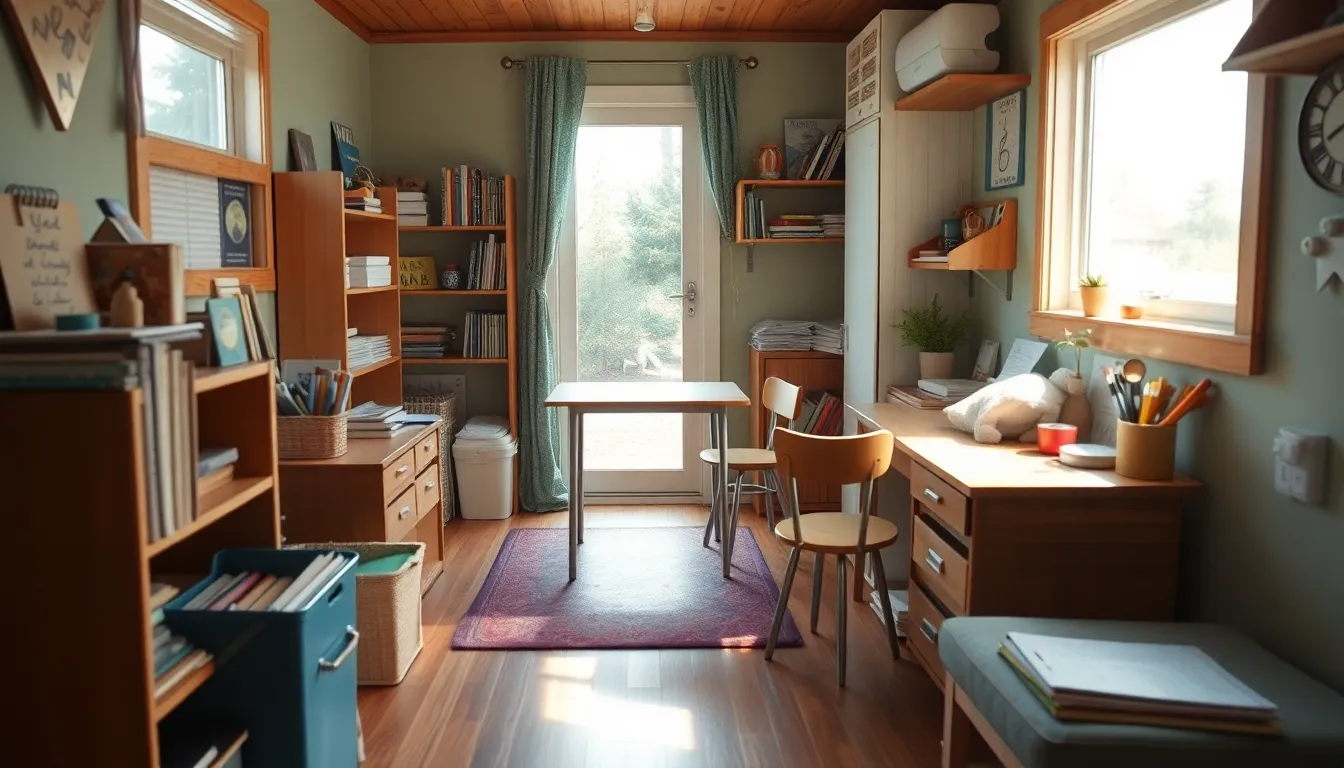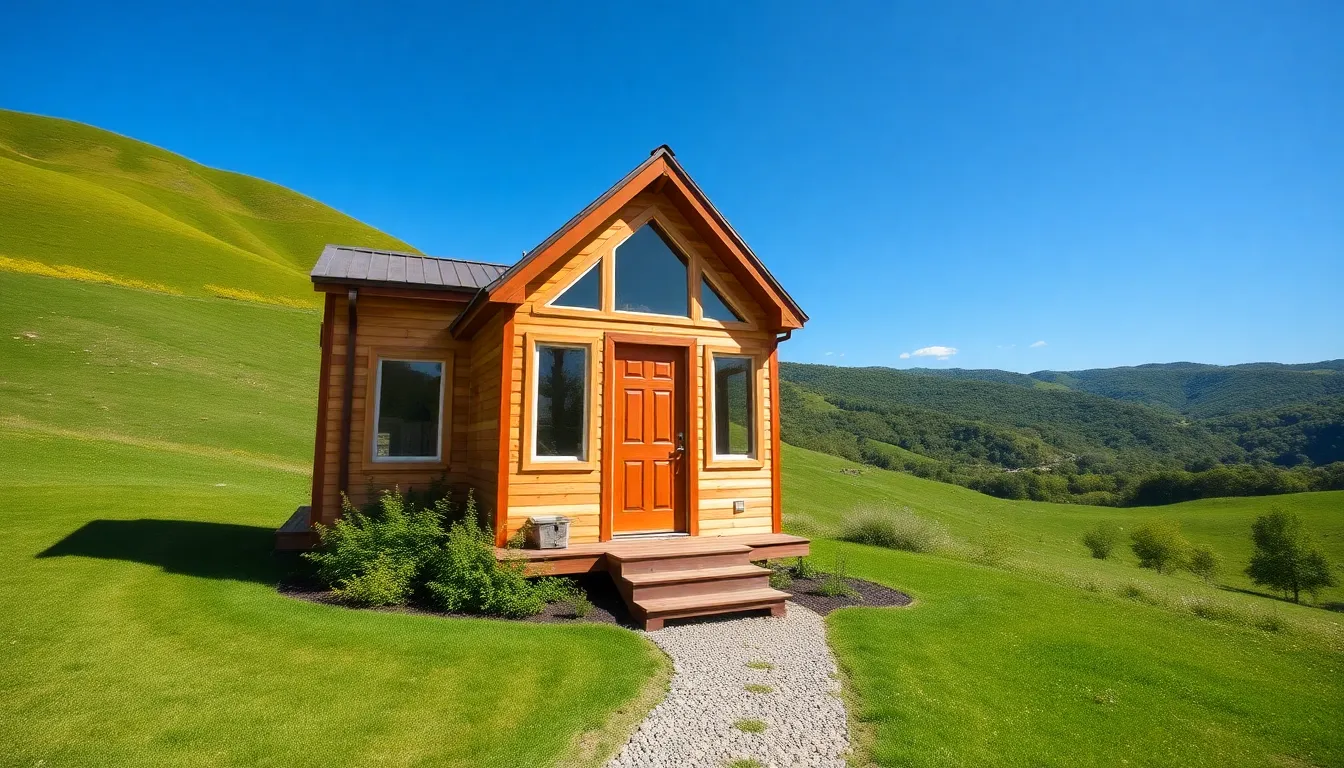Imagine transforming a cozy corner of your tiny home into a vibrant schoolroom where creativity and learning collide. With limited space, the tiny home schoolroom isn’t just a trend; it’s a lifestyle that proves good things come in small packages. Who needs a sprawling mansion when you can have a smartly designed nook that inspires curiosity and imagination?
Table of Contents
ToggleOverview of Tiny Home Schoolrooms
Tiny home schoolrooms serve as multifunctional spaces that maximize learning in limited areas. These compact environments blend functionality with creativity, making them ideal for tailored educational experiences. A well-organized nook can include essential materials like books, art supplies, and technology, all within arms’ reach.
Flexible furniture options enhance usability. Desks that fold away or stackable chairs allow for adjustments based on daily activities. Bright colors and personal touches create an inviting atmosphere, promoting engagement and enthusiasm for learning.
Tech integration plays a crucial role in tiny home schoolrooms. Devices like tablets and laptops facilitate research and collaboration, supporting modern educational strategies. Reliable internet access ensures that students can connect to resources and online classes, expanding their learning landscape.
Natural light influences the learning environment significantly. Large windows can brighten the space, reducing the need for artificial lighting and enhancing focus. Indoor plants contribute to better air quality and improve mood, creating an enjoyable atmosphere conducive to studying.
Storage solutions must address the unique challenges of a tiny home. Vertical shelving and under-desk bins aid in keeping materials organized while saving floor space. Dynamic layouts enable transitions from quiet reading sessions to interactive group activities, ensuring diverse learning experiences.
Tiny home schoolrooms exemplify how innovative design can shape education, demonstrating that effective learning spaces do not require expansive square footage. Implementing intentional design elements fosters a love of learning, inviting exploration and creativity in every corner.
Benefits of a Tiny Home Schoolroom
Tiny home schoolrooms offer numerous advantages, showcasing how compact spaces can enhance educational experiences.
Cost-Effectiveness
Creating a tiny home schoolroom significantly reduces costs. Smaller spaces require less investment in materials and furnishings. Essential resources like books and art supplies can be selected with budget in mind. Lower utility bills accompany reduced square footage, providing ongoing savings. Additionally, families often avoid high rent associated with larger spaces, allowing funds to be redirected towards quality educational tools. This approach fosters financial sustainability while maximizing learning opportunities.
Flexibility and Mobility
Flexibility defines the tiny home schoolroom experience. Mobile furniture options like foldable desks and stackable chairs enable quick reconfiguration for various activities. Spaces can accommodate different learning styles through adaptable layouts. Moving the schoolroom to outdoor areas for fresh air and inspiration is simple. Families benefit from the ability to travel, ensuring education continues wherever they go. The multifunctional aspect creates an enriching environment suitable for diverse educational experiences.
Designing Your Tiny Home Schoolroom
Creating an effective tiny home schoolroom involves careful planning and thoughtful design elements. A well-structured environment maximizes learning potential within limited space.
Space Planning
Maximizing space requires strategic layouts. Positioning desks near windows optimizes natural light, which enhances focus and creativity. Incorporating flexible furniture options allows easy rearrangement to accommodate different activities. Utilizing wall-mounted shelves provides storage without consuming valuable floor space. Prioritizing organization is key; designated areas for different subjects can streamline the learning process. Expanding the space with mirrors creates the illusion of openness. Creating distinct zones for study and relaxation fosters a balanced atmosphere, catering to various learning styles. Planning with future needs in mind ensures that the schoolroom remains adaptable over time.
Essential Features
Including essential features elevates the functionality of tiny home schoolrooms. Quality lighting options are crucial, with both natural and artificial sources working together. Incorporating a whiteboard or chalkboard enhances interactive learning experiences. Flexible seating options, such as bean bags or floor cushions, can cater to different activities and preferences. Technology integration remains vital; tablets and laptops support research and collaboration, bolstered by reliable internet access. Thoughtfully chosen decor can inspire creativity, with artwork or educational posters adding vibrancy. Ample storage solutions, such as bins or baskets, keep materials organized and easily accessible, ensuring a clutter-free environment conducive to learning.
Challenges of Tiny Home Schoolrooms
Tiny home schoolrooms present unique challenges. Limited square footage often constrains layout options, forcing families to maximize every inch. Creativity plays a crucial role in overcoming space limitations, yet it requires innovative thinking and thoughtful design. By choosing multifunctional furniture, they can ensure that areas serve multiple purposes, allowing for quick transitions between activities. Additionally, the absence of dedicated spaces may lead to distractions, making it essential for families to establish clear boundaries within shared areas.
Limited Space
Limited space can inhibit functionality in tiny home schoolrooms. Families frequently face difficulties in accommodating essential educational materials. Essential supplies like books, art tools, and technology often compete for space. When overcrowding occurs, it diminishes focus and engagement. Flexible furniture becomes vital for optimizing a small area. Utilizing wall space with vertical solutions like shelves can free up valuable floor space. Positioning desks near windows not only provides natural light but also fosters a more inviting atmosphere. Prioritizing essential items enhances the effectiveness of learning in confined settings.
Organization and Storage Solutions
Organization and storage solutions significantly influence tiny home schoolroom efficiency. Creative storage methods help families keep materials within reach while minimizing clutter. Wall-mounted shelves offer accessible storage for books and supplies, making them easy to locate. Under-desk bins can accommodate art materials and technology, maintaining an organized workspace. Labeling storage can improve retrieval times and streamline study sessions. Implementing multi-purpose furniture with built-in storage also maximizes functionality. Establishing designated zones for specific activities can further enhance organization. Efficiently managing space allows for a focused and inspiring learning environment.
Conclusion
Tiny home schoolrooms represent a transformative approach to education within limited spaces. They prove that creativity and learning can thrive even in compact environments. By integrating thoughtful design and multifunctional elements, these spaces offer unique opportunities for tailored educational experiences.
The flexibility and mobility of tiny home schoolrooms allow families to adapt their learning environments to suit various needs. With smart organization and innovative storage solutions, these nooks can remain clutter-free and focused.
Ultimately, tiny home schoolrooms exemplify how intentional design can foster a love of learning, demonstrating that effective educational spaces don’t need to be large to be impactful.







